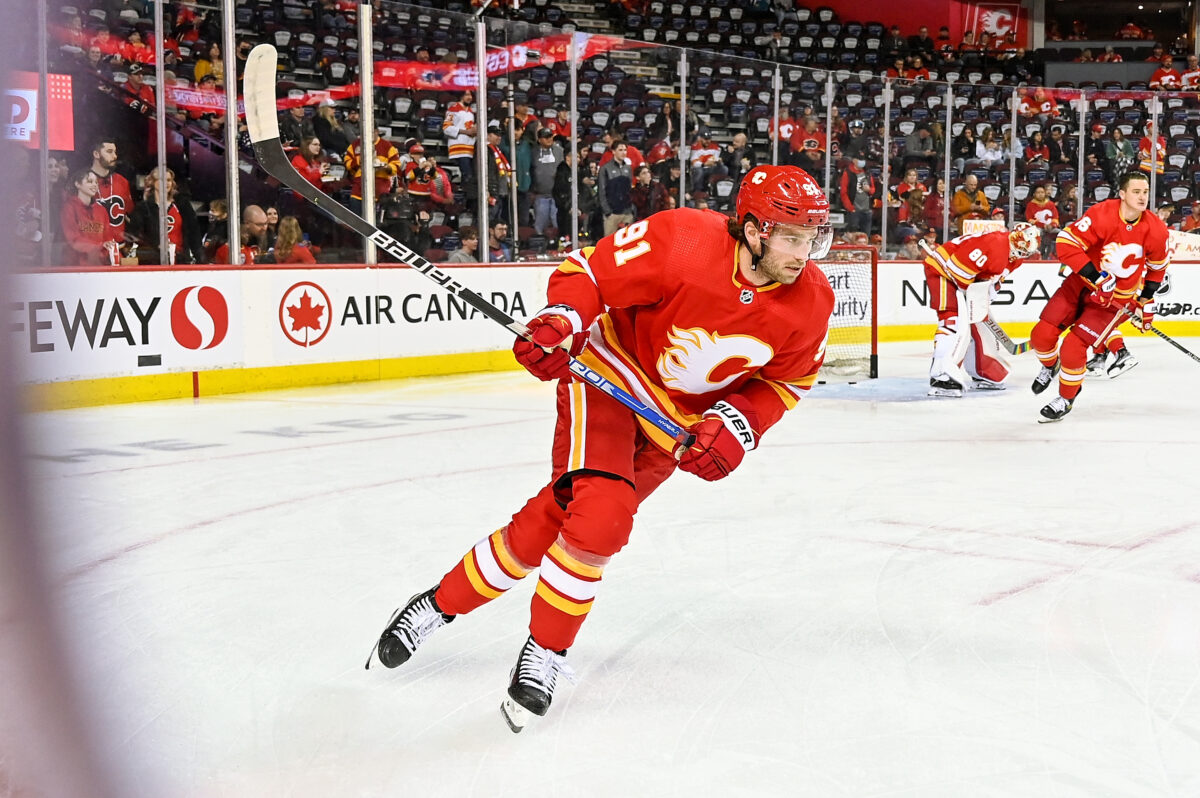This offseason, more than any other I can recall, there’s anger about what the Toronto Maple Leafs and their “idiotic” general manager Kyle Dubas have been doing to build the 2022-23 regular season’s starting roster. The anger is palpable and the choices are almost universally disparaged.
Related: Maple Leaf’s Commentary: The Honeymoon’s Over for Dubas & Shanahan
I admit that I am not always confident I know what the Maple Leafs’ management team is thinking when they make the choices they make. But I’ve come to see the success in their work: the team set a franchise record for wins and points last season. And, because I don’t have the ability to see into the future, I’ve come to trust the past.
In this edition of Maple Leafs’ News & Rumors, I’m going to first report the recent signing of Calle Jarnkrok. Then, I’m going to use that signing as an example of what I believe the team was thinking when they signed him. I believe it’s an example of the process I believe the team goes through each offseason to make roster-building choices.
Maple Leafs Sign 4-Year Contract with Calle Jarnkrok
Yesterday Calle Jarnkrok signed a four-year contract with the Maple Leafs. Jarnkrok’s four-year contract pays him $2.1 million per season.
In a recent interview, Maple Leafs’ general manager Dubas noted that his next move in free agency would likely be that the team would take a flyer on a player who saw a chance to show well with the team and leverage that opportunity into a bounce-back deal. I would have guessed a top-six possibility for a short-term contract. Jarnkrok wasn’t that signing.

(Photo by Brett Holmes/Icon Sportswire via Getty Images)
Some fans might believe the signing is also interesting because of its term of four years. However, I believe the signing makes sense because it fills the team’s need to solidify the third line as a shutdown unit.
With Jarnkrok, you get what you get. He plays good defense and puts up consistently middling but regular secondary offensive production (count on 15 goals and 30 points each season). Better yet, he seldom draws a penalty. In only one of his seasons in the NHL has he drawn more than nine minor penalties. And, he’s a consistently plus/minus positive (except for last season with the Seattle Kraken).
What the Maple Leafs Are Thinking
In short, Jarnkrok is a versatile, defensive-minded, third-line forward who can score goals and draw penalties but takes very few penalties himself. He looks to be a less expensive replacement for Alex Kerfoot, who will now almost certainly be traded with the Maple Leafs now over the salary cap (which is allowed at this time of the season). The team still must sign third-liner Pierre Engvall and defenseman Rasmus Sandin.
Related: Maple Leafs’ Dubas on the Hot Seat? Writers & Fans Weigh In
All in all, Jarnkrok is a third-line signing that to me looks like the Maple Leafs are trying to cut down on mistakes at crucial times in their play – think Game 6 of the postseason where they could have eliminated the Tampa Bay Lightning except for a couple of high-sticking penalties that cost them the game in regulation. This signing makes sense to me, although I didn’t see it coming.
Where Does Jarnkrok Fit into the Maple Leafs’ Process?
As I admitted, I didn’t see the Jarnkrok signing coming. It only made sense to me when I considered what the team was trying to do by pulling it off.
Already, a number of fans and hockey pundits have been critical of this signing. Why get him? What’s the upside? Why sign a 30-year-old to a four-year contract with a modified no-trade clause?
I think sometimes fans can miss what’s happening with the team and the process I believe the management goes through each offseason in an effort to make the team the Stanley Cup winner. That’s the goal.
I believe there’s a formal process in place; and, I for one trust it. [I’m coming to feel that I’m alone in that.]
So, What’s the Maple Leafs Process?
When I say I trust the process, I don’t simply mean I like the way they are thinking (although I do agree with that). By process, I mean the specific and formal way I believe the team’s management engages each offseason’s work. From my experience as an academic researcher and in the university leadership positions I’ve held, I think it’s the right thing to do.
Related: Where Are They Now? The Jonathan Cheechoo Edition
I trust the specific way the team is working to make its choices. It isn’t Moneyball necessarily, but it shares some of the same rigor and mathematical principles. In addition, it’s simply good business management.
Good business practice (or good research practice, which was my area as an academic) is an iterative process. The team keeps circling back to its goals by studying where the failures and successes experienced have landed them in terms of those goals.
In decision-making, iteration is the consistent repetition of this process (for the Maple Leafs it takes place every offseason) so the team can generate a sequence of actions that moves them toward their desired outcome (winning the Stanley Cup).

(Richard Lautens/Toronto Star via Getty Images)
Each repetition of the process (for an NHL team, it’s a season and an offseason) is a single iteration. And the outcome of each iteration (where the team is at the end of the season) then becomes the starting point of the next iteration (planning for the next season).
[As an aside, in computer science, algorithms work to build sets of instructions that tell a computer how to transform sets of facts about the world into information that can be used for decision-making. Specifically, this means taking the information gathered about what people did and the knowledge about how things happened and using it to instruct how to make better decisions.]
Does the Team Make Mistakes? (Yes): Does It Have Success? (Yes)
Back to the Maple Leafs, the team does make mistakes. Last offseason, as fans we were excited that the team had signed forward Nick Ritchie and even goalie Petr Mrazek. Those choices didn’t work.
Related: Maple Leafs News & Rumors: Knies, Minten & New Draft Strategy?
On the other hand, who knew much about Michael Bunting? Sure, he got lucky scoring some goals with the Arizona Coyotes, but that shooting percentage would surely come falling back to earth. And who the heck would sign David Kampf from the Chicago Blackhawks’ scrap heap? A forward who only scored a single goal in a season?
I even wrote a post about how defenseman Brennan Menell could become the team’s new power-play quarterback. Where is he now? Kurtis Gabriel brought his character to the team, then didn’t stay. Josh Ho-Sang has signed in the KHL after his season with the Toronto Marlies.
Some of these players were purely chances the team took – Ho-Sang, for example. But most were decisions the team made to see if it could address a prioritized need that was considered and decided upon as it looked back at the previous season. They were trying to answer what had happened, what they wanted to happen, and what they could do to reach the desired goal – with the resources they had.
A Series of Maple Leafs Head-Scratchers – Get Used to It
As a regular reader and commenter gcmgome noted (and I thank him for helping generate this post), some of the moves that Dubas makes as general manager seem like a cobbled-together, supporting cast of head-scratchers. gcmgome also noted that Dubas isn’t finished lifting rocks and beating the bushes yet. There will be more unforeseen additions – like Jarnkrok – to come.
Related: Maple Leafs’ GM Kyle Dubas: Using Anger as a Negotiating Tactic
For me, not being in the room where the Maple Leafs’ decisions are made, I will be forever surprised – it seems, by what happens. Will there be failures and mistakes? Of course. Will there be successes? There have been in the past.
Do I trust the process? Yes. I think it’s exactly the right thing to do.
To end with a final thought by reader gcmgome. “We can only hope that this year’s crop of castoffs nets a few home runs.” For me, that’s part of the fun of covering this team.